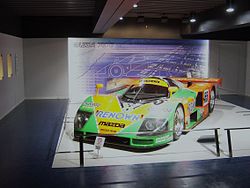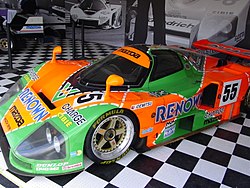Mazda 787B


The Mazda 787B was a prototype racing car built for the 24 hours of Le Mans auto race, replacing the 767. It used a 4-rotor 26B Wankel engine which produced over 700 hp (522 kW). The 787B's 1991 win at Le Mans was historic in two ways: It marked the first (and only) victory for a Japanese manufacturer, and the first (and only) overall victory for a car powered by a Wankel rotary engine. The 787B was built in Britain and was designed by Englishman Nigel Stroud. Three 787B's were entered for the 1991 event, placing first, sixth, and eighth.
Memorable paint
The most famous of the 787B cars is the #55 car, painted in an outrageous bright orange and green scheme, sporting the logos of Renown, who is an apparel manufacturer and CHARGE. The other livery was their standard blue stripes on white livery.
New challenges in 1991
In order to win the 1991 race, Mazda engineers and the 787B had some new and significant obstacles to overcome. First, a year prior, two new chicanes had been installed on the Hunaudières Straight, breaking the nearly 3-mile long straightaway into three shorter segments, thus reducing top speeds from over 240mph (370 km/h) to roughly 210mph (338 km/h). This increased stress and wear on the brakes, having to stop the car from more than 200mph three times instead of just once as on the old layout, but reduced the chances of a tire blowout which was the purpose of the chicanes.
Second, the 1991 race was run to a fuel consumption formula. Teams were allotted a specific amount of fuel, which was to be used for the entire race event - practice, qualifying and the race itself. Fuel economy would play a key part in the 787B's win.
To increase the chance of winning, Mazda installed legendary six time winner Jacky Ickx as consultant, who then hired French outfit Oreca to run the team. Ickx felt the car was running on too much weight and continued to persuade the FIA to allow the car to run with less weight than previously.
The power of the 4-Rotor Wankel Engine
The 787B's 4-rotor Wankel powerplant was specifically developed for this race and featured Peripheral Porting in order to achieve the high levels of power from a naturally aspirated motor. (Road cars utilizing two-rotor engines, such as the Mazda RX-7, more often use turbochargers to obtain a high power output.)
The 787B's 26B Wankel engine benefitted from a variable intake system, optimizing air intake for certain vehicle speeds. Two periscope-shaped air intakes were mounted ahead of the rear wing. Each intake assembly was mated to a telescoping-pulley system which was able to vary the height of the protruding periscopes through a stroke of approximately six inches. The extension and retraction of the intakes was governed by the car's ECU computer depending on vehicle speed. At high speed, the intakes were retracted to decrease drag and smooth airflow over the rear wing, and to reduce the restrictions on the air flow into the engine. At lower speeds, the intakes were extended in order to provide maximum positive pressure to the charge entering the rotors.
Engine speed (RPM's) were deliberately kept low for longevity under the extreme stresses incurred during a 24-hour automobile endurance race. The 787B was reported to have a redline around 9000rpm. However, interviews with Mazda's 787B race engineers revealed that the power of the quad-rotor increased dramatically above 9000rpm. One engineer stated that the car could develop more than 930hp with a redline around 10,500rpm. Engineers also commented that during the post-race inspection and tear-down of the quad-rotor engine they discovered that all aspects of the engine were still in excellent condition and could have run another 24-hour race. This is a polarizing testament to the reliability and performance of the modern Wankel rotary engine.
Publicity
Despite the enormous success of the 787B and its Wankel powerplant, Mazda didn't fully exploit its historic victory through marketing campaigns and advertising. The 1991 Le Mans victory did strengthen sales a bit for Mazda's road cars. In the United Kingdom, Mazda would release a special edition of its MX-5 with the racing color and also a BBR (Brodie Brittain Racing) turbo conversion; the car is one of the most sought after special edition cars of its model. Long a proponent of the rotary engine, Mazda has maintained a rotary-engined road car for many years, though sales of the Mazda RX-7 were stopped in most U.S. states in 1996 (and in Japan in 2002) until release of the 2003 Mazda RX-8. The Mazda RX-8 utilized a new generation of the Mazda Wankel engine, dubbed "RENESIS" which uses side intake and exhaust ports.
Life after Le Mans
At the end of the 1991 season, the FIA (Federation Internationale de l'Automobile) outlawed the use of Wankel-type rotary engines in the racing series which it governed to solely allow cars with the 3.5L F1 engine to compete as the had concerns over top speed at the Mulsanne Straight a few years earlier. The 1991 24 Hours of Le Mans would be the last time the 787B would compete in international motor racing, with the Mazda MXR-01 entered by Mazda the following year powered by a Judd unit.
Of the winning drivers Herbert would have a successful a career in Formula One, notching up three wins before leaving the championship in 2000 and returning to sportscar racing. Gachot, despite a few false starts prior to his career would fare better as he had improved his form in Jordan Grand Prix before being given an eighteen months prison sentence in August for a CS gas attack on a taxi driver in London, his place for the Belgian Grand Prix was famously filled by newcomer Michael Schumacher. He was finally released after two months and had minor successes since before retiring altogether. Weidler would compete in the Japanese Formula 3000 championship, only to have his career cut short when he was diagnosed with tinnitus, recommending he should take time off to allow for an operation but he chose to retire from the sport and handing over his drive to Heinz-Harald Frentzen.
The 26B engine would be used by Mazda in its Mazda RX-792P for its premier IMSA GTP category with a limited success, before alongside Nissan and Jaguar, withdraw from the series. The engine would continued to be used for its sister category, the GTS for cars that resembles production cars.
There are however many series that are not under the governance of the FIA, most notably Le Mans and the American Le Mans (ALMS) and Le Mans Endurance (LMES) series. B-K Motorsport competed a Courage C65 LMP2 prototype in ALMS in 2005, powered by a Mazda tri-rotary; and painted in a yellow and blue version of the livery worn by the 787B.
Today the car is considered by Mazda and Rotary enthusiasts as one of the most iconic cars to come from Japan despite its non-Japanese origin. The 787B have been celebrated by virtually every major toy and model companies in Japan who had produced models of the car with its winning livery. To show the car's popularity in Japan, the 787B in its renowned livery is considered as the most popular of the Gr. C cars to appear in video games, with its first appearance in Sega's arcade game Le Mans 24 in 1998, then in Gran Turismo 3 and can also be seen in both Enthusia Professional Racing and the Gran Turismo follow-up Gran Turismo 4. Due to its iconic status, Mazda has refused to restore the winning car, which resides at the Le Mans museum.
Specifications
- Construction: carbon fiber and tubular space frame
- Weight: 830 kg (1831 lb)
- Wheelbase: 2.66 m
- Length: 4.78 m
- Track (F/R): 1.53/1.50 m
- Width: 1.99 m
- Wheels: 18 in Magnesium Alloy
- Tires (F/R): Dunlop 300-640x18/355-710x18
